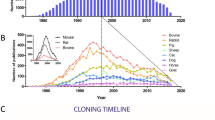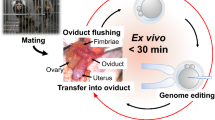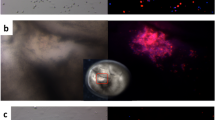Abstract
Several mammals — including sheep, mice, cows, goats, pigs, rabbits, cats1, a mule2, a horse3 and a litter of three rats4 — have been cloned by transfer of a nucleus from a somatic cell into an egg cell (oocyte) that has had its nucleus removed. This technology has not so far been successful in dogs because of the difficulty of maturing canine oocytes in vitro. Here we describe the cloning of two Afghan hounds by nuclear transfer from adult skin cells into oocytes that had matured in vivo. Together with detailed sequence information generated by the canine-genome project5,6, the ability to clone dogs by somatic-cell nuclear transfer should help to determine genetic and environmental contributions to the diverse biological and behavioural traits associated with the many different canine breeds7,8.
Similar content being viewed by others
Main
Successful somatic-cell nuclear transfer (SCNT) depends on the quality, availability and maturation of the animal's unfertilized oocytes. Unlike other mammals, dogs ovulate at first meiotic prophase, and their oocytes mature for 2 to 3 days in the oviduct's distal regions. Previously, intra- and interspecific canine embryos have been constructed by canine SCNT into canine and bovine oocytes, respectively, but this did not result in viable offspring9.
We collected oocytes matured in vivo at metaphase II about 72 hours after ovulation by flushing the oviducts. (For details of methods, see supplementary information.) Donor fibroblasts were obtained from an ear-skin biopsy of a male Afghan hound and cultured for two to five passages (in which fully grown cells are transferred to a new culture dish). For SCNT, the chromosomes of the unfertilized canine oocytes were removed by micromanipulation, and a single donor cell was transferred into each enucleated oocyte. The couplets were fused and only successfully fused couplets (75%) were activated. The activated oocytes were then transferred into the oviducts or uterine horns of recipient dogs at times appropriate to the embryos' developmental stages. We collected an average of 12 oocytes from each female, and a total of 1,095 reconstructed canine embryos were transferred into 123 recipients.
Three pregnancies were confirmed by ultrasound scans at 22 days' gestation in recipients after transfer of constructs. Pregnancy was established only after embryo transfer of very-early-stage nuclear-transfer constructs (that is, less than 4 hours after oocyte activation). This transfer of early-stage embryos is a crucial factor in successful assisted reproductive technology for dogs. One fetus miscarried and two others were carried to term.
We named the first cloned dog Snuppy (for Seoul National University puppy); it is shown in Fig. 1a with the male Afghan fibroblast donor. Snuppy was delivered by caesarian section after 60 days (full term) from a yellow Labrador surrogate mother (Fig. 1b); his birth weight was 530 g. The second SCNT dog, NT-2, was carried by a mixed-breed surrogate, and was also delivered at 60 days, weighing 550 g (normal range for Afghans in a litter, 482–680 g). He experienced neonatal respiratory distress during the first week, seemed to recover, but died on day 22 as a result of aspiration pneumonia; no major anatomical anomalies were evident post mortem.
a, Snuppy, the first cloned dog, at 67 days after birth (right), with the three-year-old male Afghan hound (left) whose somatic skin cells were used to clone him. Snuppy is genetically identical to the donor Afghan hound. b, Snuppy (left) was implanted as an early embryo into a surrogate mother, the yellow Labrador retriever on the right, and raised by her.
We tested whether the cloned dogs were genetically identical by microsatellite analysis of genomic DNA from the donor Afghan, the cloned dogs and the surrogates (see supplementary information). Analysis of eight canine-specific microsatellite loci confirmed that the cloned dogs were genetically identical to their donor dog. However, the efficiency of cloning is still very low (2 dogs from 123 recipients, or 1.6%) compared with the rates for cats1 and horses3.
In addition to the benefits that cloning technology may generally provide (the preservation of rare species and therapeutic cloning — once canine embryonic stem cells become available), this technology could become a useful research tool for studying the genetics of outcrossed populations.
References
Shin, T. et al. Nature 415, 859 (2002).
Woods, G. L. et al. Science 301, 1063 (2003).
Galli, C. et al. Nature 424, 635 (2003).
Zhou, Q. et al. Science 302, 1179 (2003).
Ostrander, E. A. & Giniger, E. Am. J. Hum. Genet. 61, 475–480 (1997).
Sutter, N. B. & Ostrander, E. A. Nature Rev. Genet. 5, 900–910 (2004).
Lohi, H. et al. Science 307, 81 (2005).
Modiano, J. F. et al. Cancer Res. 65, 5654–5661 (2005).
Westhusin, M. E. et al. J. Reprod. Fert. Suppl. 57, 287–293 (2001).
Author information
Authors and Affiliations
Corresponding author
Ethics declarations
Competing interests
The authors declare no competing financial interests.
Supplementary information
Rights and permissions
About this article
Cite this article
Lee, B., Kim, M., Jang, G. et al. Dogs cloned from adult somatic cells. Nature 436, 641 (2005). https://doi.org/10.1038/436641a
Published:
Issue Date:
DOI: https://doi.org/10.1038/436641a
This article is cited by
-
Reprogramming mechanism dissection and trophoblast replacement application in monkey somatic cell nuclear transfer
Nature Communications (2024)
-
Use of laboratory animals and issues regarding the procurement of animals for research in Korea
Laboratory Animal Research (2023)
-
Derivation of embryonic stem cells from wild-derived mouse strains by nuclear transfer using peripheral blood cells
Scientific Reports (2023)
-
Generation of genome-edited dogs by somatic cell nuclear transfer
BMC Biotechnology (2022)
-
Insights from one thousand cloned dogs
Scientific Reports (2022)
Comments
By submitting a comment you agree to abide by our Terms and Community Guidelines. If you find something abusive or that does not comply with our terms or guidelines please flag it as inappropriate.




